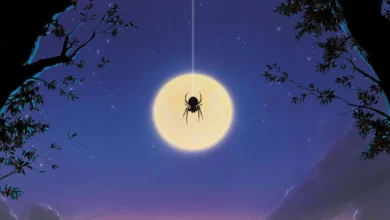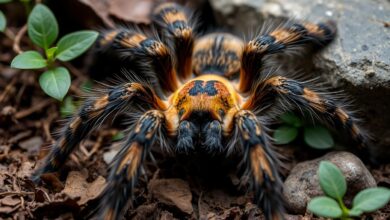Myths and Facts about Tarantulas
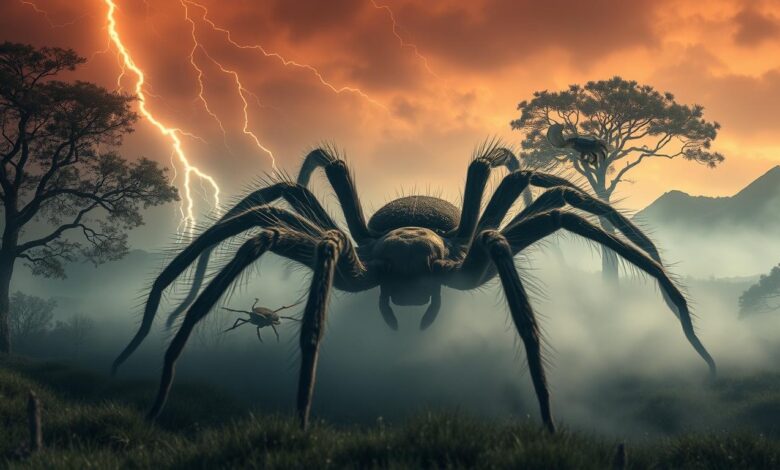
Tarantulas are fascinating arachnids with many myths and misconceptions. This article aims to clear up these myths, giving you a full understanding of these creatures. We’ll look into the truth behind tarantula myths, their gentle nature, the reality of their venom, and the variety of tarantula species. By the end, you’ll see tarantulas in a new light and appreciate their important role in nature.
Introduction: Shedding Light on the Misunderstood World of Tarantulas
Tarantulas have always sparked curiosity and confusion. Many people think they know them, but they are much more complex. We will look into their allure and mystery to understand them better.
The Allure and Intrigue of These Captivating Arachnids
Tarantulas are fascinating because of their unique looks and behaviors. They come in many colors and sizes, from bright to big. Their ways and facts have caught the interest of many, showing they are more than just spiders.
People find their webs and movements interesting. By learning more about them, we see how important they are in nature. They help keep our ecosystems balanced.
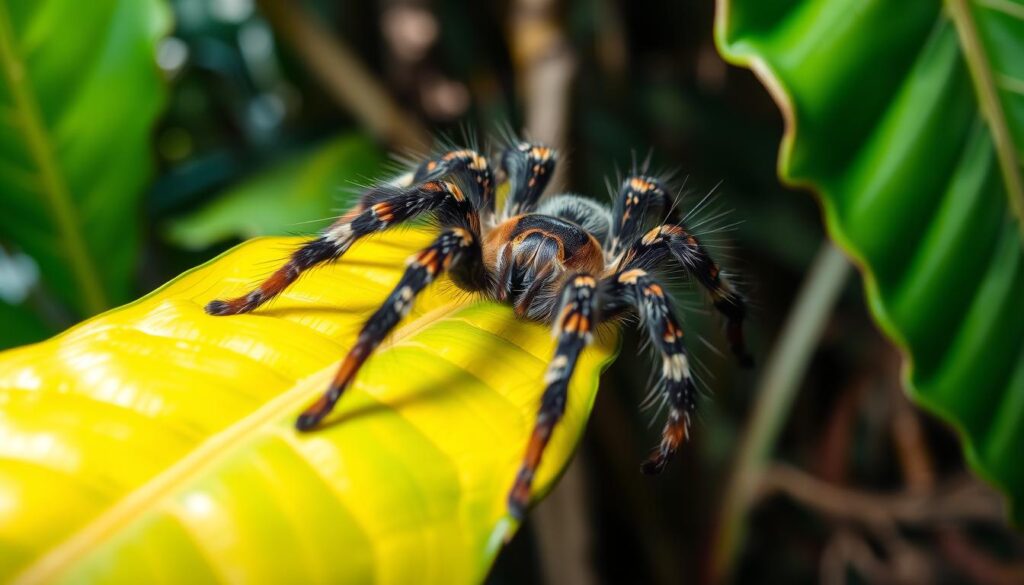
Let’s explore more about tarantulas. We’ll look at their traits, actions, and the myths around them.
Debunking Common tarantula myths
Tarantulas are fascinating creatures that have caught the eye of many. Yet, they are also surrounded by many myths and misconceptions. From being seen as aggressive and deadly to the idea they can leap far, these myths have spread fear and confusion. We will look into and clear up some of the most common tarantula myths. This will help you see these amazing arachnids more clearly and accurately.
Myth: Tarantulas are Aggressive and Dangerous
Many think tarantulas are aggressive and a big threat to humans. But, tarantulas are actually quite calm and won’t attack unless they feel threatened. Their venom isn’t deadly to humans, and they usually run away instead of fighting.
Myth: Tarantulas Can Leap Large Distances
It’s also believed that tarantulas can jump or leap over big gaps. This isn’t true. Tarantulas can move fast, but they can’t jump or leap. They mainly walk or crawl, and sometimes they stand up to scare off predators.
| Myth | Fact |
|---|---|
| Tarantulas are aggressive and dangerous | Tarantulas are generally docile and their venom is not lethal to humans |
| Tarantulas can leap large distances | Tarantulas are limited to crawling and walking, with no ability to jump or leap |
We aim to clear up these and other tarantula myths to help people understand and appreciate these amazing arachnids better. Keep reading as we delve deeper into the world of tarantulas and share more tarantula facts.
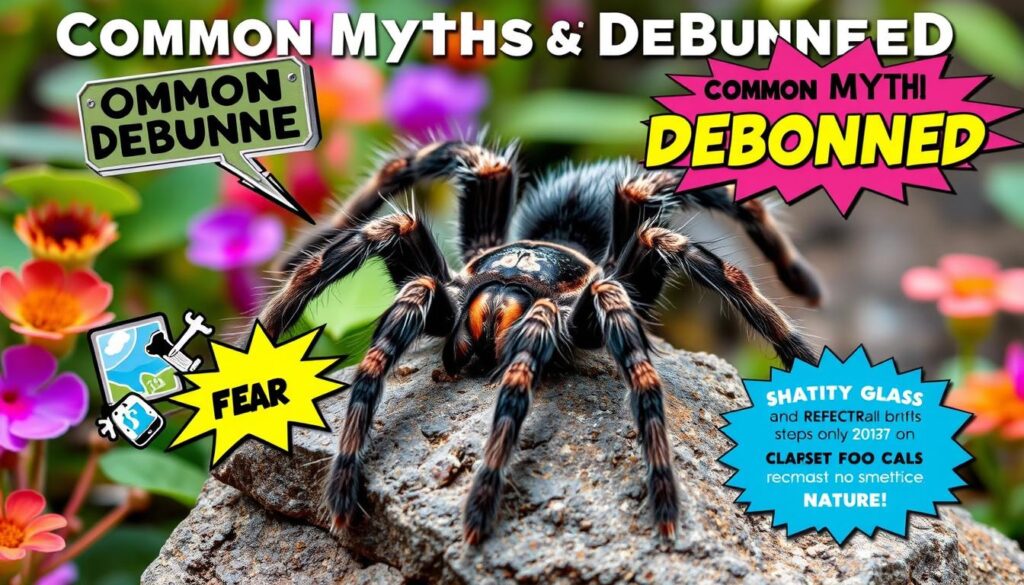
 Tarantulas for sale
Tarantulas for sale
The Tarantula’s Gentle Nature: Demystifying Their Behavior
Tarantulas look scary but they are actually gentle and don’t like to fight. Many people think they are aggressive and dangerous. But, they usually try to run away instead of fighting.
Tarantulas behavior shows they don’t like to fight much. They eat insects and sometimes fruits like bananas. Some big tarantulas might eat small birds, but most eat crickets and cockroaches.
People often think tarantulas are mean because they look scary. But, they are actually pretty calm and don’t like to fight. When they feel threatened, they usually run away instead of fighting. This shows they are not as aggressive as people think.
Learning more about tarantulas helps us see how interesting they are. They don’t like to fight and would rather run away. This shows they are actually pretty gentle, which goes against what many people believe.
tarantula venom: Understanding the Reality of Their Bite
Many people think tarantulas are super dangerous because of their venom. But, the truth is, their bites are usually not harmful to humans. Let’s look closer at tarantula venom and how it affects people.
Most tarantulas can’t bite humans because their fangs are too weak. Only a few spiders, like the Brazilian Wandering Spider, are really dangerous to humans.
If a venomous spider bites you, you might feel a lot of pain, have redness and swelling, or even have trouble breathing. But, it’s rare for someone to die from a spider bite. For example, Redback Spider bites are usually not deadly thanks to the anti-venom.
Knowing about tarantula venom helps you understand the real risks. If you think you’ve been bitten by a venomous spider, get medical help right away. Quick treatment can help prevent serious problems.
To avoid spiders, keep your home tidy and shake out your clothes before wearing them. Always wear gloves when you’re outside, and be careful in places like basements and attics where spiders might live.
Exploring the Diverse World of tarantula species
The world of tarantulas is full of vibrant colors and unique traits. It’s a place where around 850 different species live. Each one has its own special look and way of surviving.
From Vibrant Colors to Unique Adaptations: A Glimpse into Their Variety
Tarantulas show off in many colors, from bright blues to deep earth tones. These colors help them warn off predators or keep them away.
 What does the tarantula eat?
What does the tarantula eat?
They’re not just colorful; they’ve also adapted to their environments. Some have hairy bodies that ants can’t bite through. Others hang from leaves to stay safe.
| Tarantula Species | Distinctive Traits | Habitat |
|---|---|---|
| Poecilotheria spp. (Ornamental Tree Spiders) | Vibrant, iridescent colors; fast movements | Tropical forests of Asia |
| Nhandu spp. (Brazilian Red and White Tarantulas) | Rich, earthy tones; powerful burrowing abilities | Dry, arid regions of Brazil |
| Avicularia hirschii (Peruvian Green Velvet Tarantula) | Arboreal lifestyle; less hairy compared to burrowing species | Rainforests of Peru |
Tarantulas are truly fascinating creatures. They show us how adaptable and resilient life can be.
tarantula habitats: Unveiling the Environments They Call Home
Tarantulas live in many places around the world. They can be found from the green rainforests of South America to the dry deserts of the southwestern United States. These spiders have adapted to different environments, each with its own challenges.
In the lush tarantula habitats of the Amazon, these spiders hide in thick plants. They dig complex tunnels underground. Their bright colors and big size help them hide from predators.
In the tough tarantula environments of the southwestern deserts, tarantulas live in harsh conditions. They can save water and dig deep to escape the heat and find food.
Tarantulas live in many places, from wet rainforests to dry deserts. They have learned to survive in different tarantula living conditions. This shows how adaptable and strong these spiders are.
| Habitat Type | Characteristics | Adaptations |
|---|---|---|
| Tropical Rainforest | Lush vegetation, high humidity, moderate temperatures | Burrowing, camouflage, nocturnal behavior |
| Desert | Arid, hot, limited water resources | Water conservation, deep burrowing, nocturnal activity |
| Temperate Deciduous Forest | Moderate temperatures, seasonal changes, diverse vegetation | Tolerance to temperature fluctuations, ability to adapt to changing environments |
Responsible tarantula husbandry: Caring for These Fascinating Creatures
If you love keeping tarantulas as pets, you need to know how to care for them. They have special needs for their home, food, and overall health. Here, we’ll give you tips to keep these amazing arachnids safe and happy.
Creating the Perfect Tarantula Habitat
It’s key to give your tarantula the right home for its health. Try to make the enclosure like their natural home, with the right kind of bedding, places to hide, and good air flow. Think about what your tarantula likes, as some like it dry and others like it more humid.
- Choose an enclosure that’s big enough for your tarantula to move and dig.
- Use a good substrate like coconut fiber or vermiculite to keep the right humidity.
- Add hiding spots, such as cork bark or fake plants, for your tarantula’s safety.
Feeding Your Tarantula: A Balanced Diet
Feeding your tarantula right is key for its health and growth. They mainly eat insects, and what they need can change with the species. Give them a mix of insects like crickets, mealworms, or roaches.
- Figure out how often to feed based on your tarantula’s size and age.
- Make sure the food is the right size, as tarantulas can only eat prey that’s smaller than them.
- Keep a shallow dish of water for your tarantula to drink from.
By following these tips, you can make a great home for your tarantulas. This way, you can enjoy watching them for many years.
The Importance of tarantula Conservation: Protecting Their Future
Tarantulas are fascinating creatures, but they face many threats like habitat loss and illegal trade. It’s important to understand their role in ecosystems to protect them. They are key to maintaining the balance in many environments, acting as both predators and prey.
 What is a natural tarantula repellent?
What is a natural tarantula repellent?
Protecting tarantulas involves working together. Scientists, conservationists, and policymakers are all part of the effort. Preserving their habitats is crucial, giving them the space and resources they need. Stopping the illegal pet trade and spreading awareness about conservation are also key steps.
By supporting tarantula conservation, you can help ensure their survival. Together, we can protect ecosystems and keep the world of tarantulas alive for the future. Let’s work together to preserve their world.
